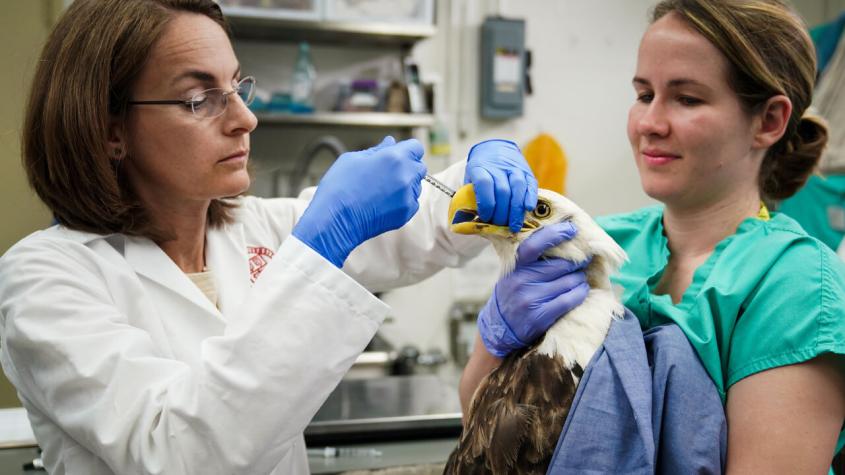Injured bald eagle successfully recovers at the Janet L. Swanson Wildlife Hospital
When she arrived at the Janet L. Swanson Wildlife Hospital, patient 23304 was not doing well. She had been hit by a car the night before.
Despite her eye-catching white head and bright yellow beak, the driver saw the bald eagle too late. Found on the side of the road near a boat launch, her rescuers believed she had been eating a discarded fish when the accident happened.
New York State Department of Environmental Conservation Officer Brent Willson immediately brought the injured eagle to the wildlife hospital where Sara Childs-Sanford, D.V.M. ’99, assistant professor and section chief of wildlife medicine, could assist her.
When she arrived, the patient was in a daze; she didn’t react to her surroundings as a healthy wild eagle should, she trembled and pushed her face into a corner of her cage for no apparent reason. These changes in her behavior indicated a brain injury — but could also mean something more sinister.
“These symptoms are similar to those observed in birds with highly pathogenic avian influenza,” says Childs-Sanford. "We had to test the patient for this virus.”

Cases of the highly pathogenic avian influenza, also known as H5N1 bird flu, has been confirmed in almost 7,000 wild birds, and caused the death of 60,000,000 poultry in the United States at the time of this writing, according to the Centers for Disease Control and Prevention. Affected chickens have a 90% to 100% mortality rate in 48 hours. Avian influenza has had a significant impact on bald eagles, and the wildlife hospital has seen several positive eagle cases since the outbreak began. Childs-Sanford isolated the eagle from other patients while she waited for the test results.
While the test came back negative, patient 23304 was not out of danger. For the eagle to recover, Childs-Sanford needed to reduce the swelling in her brain. The hospital team administered several medications to accomplish this and reduce her discomfort. Dr. Eric Ledbetter, the James Law Professor of Ophthalmology and ophthalmology section chief, also found that the eagle suffered from small retinal tears in both eyes.
With such severe head trauma, it took several days of the veterinary team’s expert care for the eagle to show signs of improvement. But with time, "she slowly became more energetic and began to display normal behaviors for an adult female eagle," says Childs-Sanford.
A month after her arrival at the wildlife hospital, patient 23304 was ready to be discharged. She will be transferred to a licensed wildlife rehabilitator in Greene County, New York. Here, she will practice flying and regain strength until she is strong enough to be released to her original territory.
This patient’s story is not an isolated one. The wildlife hospital sees about 40 bald eagles each year, with a variety of conditions. Eagles are commonly victims of trauma, often hit by cars when they are eating dead animals on the side of the road.
While some accidents are unavoidable, there are ways to help protect these majestic creatures. "This eagle was drawn to the roadside by discarded fish," says Childs-Sanford. "Fishermen should avoid discarding fish near roadways, and drivers can be on alert for eagles and other scavenging animals on roadside carrion."
Written by Elodie Smith
Please consider giving to the Janet L. Swanson Wildlife Hospital to support the care of wild animals like the bald eagle.





